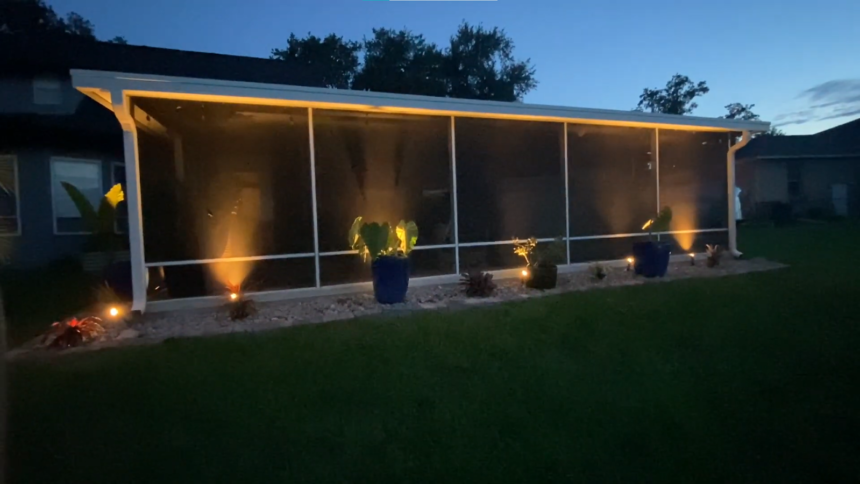Low voltage landscape lighting can transform any outdoor space into an enchanting fairytale. That’s not to mention its more practical benefits, which provide you with increased safety and functionality. However, to make the most of these lights, it’s important you understand how they’re properly installed and maintained over time.
- Collection of Materials
- Assembling the Light Fixtures
- Planning Landscape Layout
- Connecting the Wire
- Installing the Low Voltage Transformer and Timer
- Test Each Fixture
- Hide the Wires
- Should landscape lights be low voltage?
- How far can you run low voltage landscape lighting?
- How deep do you bury landscape lighting at low voltage?
That’s why this article goes into detail about low voltage outdoor lights, including their various benefits, installation process, and much more.
What is Low Voltage Landscape Lighting?
Low voltage landscape lighting is a type of lighting system that operates on a 12-volt power supply rather than the standard 120-line voltage. They’re typically used in outdoor spaces like gardens, walkways, or patios. Once the sun sets, these lights emit a warm glow that improves the beauty of its surroundings and lets you enjoy a well-lit outdoor space.
Additionally, this system consists of light fixtures that come in various styles and price ranges. So, you must opt for a design that fits your budget and the overall outdoor aesthetic you’re going for.
Advantages of Low Voltage Landscape Lighting
To better understand its significance, here are some benefits of low voltage landscape lighting:
- Economy: Low voltage lights are significantly more cost-effective than their counterparts. They manage to reduce expenses through affordable fixtures and bulbs while also consuming much less energy. This leads to savings on both your upfront cost and future energy bills.
- Simplicity: They’re much easier to install as they don’t require extensive electrical experience or tools. One can simply look up installation tips and instructions to better guide them through the process. It also helps that the fixtures are lightweight enough to easily move around and adjust to your landscaping needs.
- Safety: Since this lighting operates on a 12-volt power supply, it’s one of the safest options for outdoor use. The low voltage greatly reduces the risk of electrical shock and injury, even in wet weather. This makes it an ideal choice for areas accessible to children and pets, as they might come into contact.
- Versatility: As mentioned before, this lighting system offers a variety of fixtures and bulbs to choose from. You can experiment with different designs and functions, such as spotlights, path lights and well lights. From then on, you can choose the lighting that best affects the features of your landscape.
Do-It-Yourself or Hire a Professional?
Although installing low voltage lighting is considerably safer than high-voltage systems, there’s still a slight risk of electrocution. Most DIY installations require a clear understanding of how to splice wires, install transformers, and set up fixtures. Without any of this prior knowledge, you’re more susceptible to electric shocks than the experienced individual.
The risk of electrocutions is especially dangerous if you have a heart condition or any other medical concern. In such cases, you’re better off hiring a professional landscape light installer for safer installation and reliable results.
How Do I Install Low Voltage Landscape Lighting?
Here’s a step-by-step guide on how you can install low voltage landscape lighting for your outdoors:
Collection of Materials
Before starting the installation process, you must select and gather the necessary materials. This includes the following:
- Light bulbs and fixtures: Choose these components based on where you want to place them and how much light you need. You should also calculate the bulb’s wattage to determine the number of lights your system can support.
- Wire connectors: Use these to connect the wires from the power source to the light fixtures. Do not forgo this tool, as it secures a stable electrical connection and prevents short circuits.
- Wires: For this, you must opt for low voltage wires. They will safely transmit the power supply from your transformer to the light fixtures.
- Transformer: This device is responsible for reducing the 120-volt electricity to a safer 12-volt for your lighting system. It powers the fixtures and allows them to operate efficiently.
- Light sensors and timers: These components automate the lighting system. Sensors activate the lights when it gets dark outside, while timers let you schedule when they should turn on and off.
Assembling the Light Fixtures
Begin by assembling the light fixtures according to the manufacturer’s instructions. Every part should be securely fitted together and ready for placement. This includes attaching the bulbs and the stake used to mount it into the ground.
Planning Landscape Layout
Carefully plan where you want to place each fixture in your landscape. The lights should be set up in such a way that they evenly brighten the area and don’t overlap. It also helps to actually lay out the fixtures and wires along the landscape to visualize the setup and avoid issues of insufficient wire length.
Connecting the Wire
Use waterproof wire connectors to attach the wires from each fixture to the transformer. For this step, you might also need to cut off and strip 1/2 inch of insulation from the ends of the wires. Otherwise, you won’t be able to install the connectors.
Installing the Low Voltage Transformer and Timer
Install a low voltage transformer near a power source and connect it to the main wire. If included, you can also install the timer next to it. Once it’s all connected, verify that your voltage matches with your fixtures to maintain a stable lighting system.
Test Each Fixture
Now’s the time to turn on the system and check the voltage level of each light fixture. The appropriate range should vary between 10.5 and 12 volts. However, anything outside this range could indicate a poor connection or risk of premature burnout.
Hide the Wires
Once you’re satisfied with the lighting setup, you can hide the wires to give a cleaner appearance. Most people bury them under soil or among shrubbery to keep them hidden yet accessible for future purposes.
How Do I Troubleshoot Low Voltage Landscape Lighting?
If your lights aren’t working properly, you’ll need to troubleshoot the system to find out what’s wrong. Here’s a few things you can do:
- Make sure the main power source is plugged in and that the transformer is supplied with adequate power.
- Examine the wire for signs of damage or erosion. If so, you must have it repaired or replaced by a professional.
- Check each light bulb to see if it’s burnt out. If you find damaged bulbs, replace them with new ones of the same wattage.
FAQs
Should landscape lights be low voltage?
Low voltage landscape lighting is generally recommended for residential areas because it is cheaper, easier to install, and safer than high voltage lighting.
How far can you run low voltage landscape lighting?
The distance a low voltage landscape light will run depends on the wire gauge and the total wattage of the light:
14/2 low voltage cord: up to 100 feet at 60 watts total wattage
12/2 Low Voltage Cord: Up to 200 feet with 60 watts total wattage
10/2 Low voltage cord: up to 300 feet at 60 watts total wattage
How deep do you bury landscape lighting at low voltage?
According to the National Electrical Code (NEC), low-voltage landscape lighting wires should be buried at least six inches deep. This depth ensures that the wires will not be damaged or relaid by trimmers.
Conclusion
Low voltage landscape lighting provides a reliable and energy-efficient solution to any outdoor residential area. However, it’s important that you first understand the basic set-up and maintenance of installing these light systems to preserve a well-lit and safe landscape.















